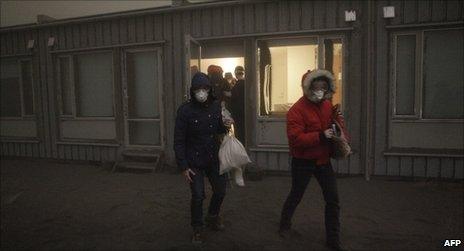Iceland volcano: Life under the ash cloud
- Published

Masks and goggles are essential in Kirkjubaejarklaustur
The ash spewing from Iceland's Grimsvotn volcano has done more than disrupt air travel. For those living nearby, it has shut out the daylight and smothered buildings and vehicles in dust.
The scene is surreal. As we drive towards the tiny town of Kirkjubaejarklaustur (it translates as "monastery of the Church Farm"), it's as if we have been transported back to winter and are trying to keep the car on the road in the total darkness of a full-force snowstorm.
Only it isn't winter. It's late May and under normal circumstances, it's bright more than 20 hours a day at this time of year.
This isn't snow, either. It's ash, a horrible substance - a grey, brownish dust that gets everywhere. It ruins the zippers on your clothes, and has already sent a lot of our camera equipment back to Reykjavik, dead from the dust.
I was not prepared for what awaited us at Klaustur - it's like a scene from one of those futuristic end-of-the-world films.
No one dares set a foot outside without a mask and goggles for eye protection.
The wind blows from all directions, and I'm covered in ash from top to toe in the 20 seconds it takes to run from the car into the only store in town. Which is, by the way, still open.
Iceland's Foreign Minister 脰ssur Skarph茅dinsson: "We are used to volcanos in Iceland"
"People are just staying at home, emptying the refrigerator - then they have to get food somewhere," says Unnar Steinn, the owner of the store.
The school is obviously closed, and rescue teams have to assist the staff of the health clinic to get to and fro work.
The cars still work, but you have to change all the filters frequently - and obviously avoid turning the air conditioning on.
Fire mountains
I'm born and raised on this volcanic island, and am used to hearing the stories of the incredible Katla eruption in 1918.
Not to mention the Lakagigar eruption in the late 18th Century which "turned day into night" and killed half the nation's livestock. My respect to my ancestors who got through that - I can finally understand what it must have been like.
Emergency workers bring in supplies
In the 21st Century, we can at least flee into a concrete building and catch our breath.
It's physically impossible to stay outside more than a couple of minutes at the time. It's hard to breath. You cry constantly as the eyes try to fight the ash. I will not describe in detail what happens when you blow your nose.
The screen I'm typing this on is covered with dust, as is the keyboard, mouse and the coffee cup beside me.
The poor staff at the hotel, which should be full of tourists, are constantly mopping the floor, vacuuming and changing towels laid against the doors and windows in an effort to keep the ash out.
But the stuff just keeps seeping in.
The ash seeps in despite towels blocking doors and windows
The hotel's new owners have just finished a refresh on the upper floor, with everything freshly painted and the curtains cleaned. It's all ruined.
"I was hired as a waitress," a girl says as she mops the floor around me for the fifth time this morning.
The strange thing is that people aren't leaving. They're stubborn, the residents of this region.
The ones I've met just say: "This is going to be over soon and we're going to get through this together just like the generations before us. Let's just hope Katla doesn't go off next year."
Fingers crossed.
Thora Arnorsdottir is a senior reporter at RUV, the Icelandic National Broadcasting Service.
- Published24 May 2011
- Published23 May 2011